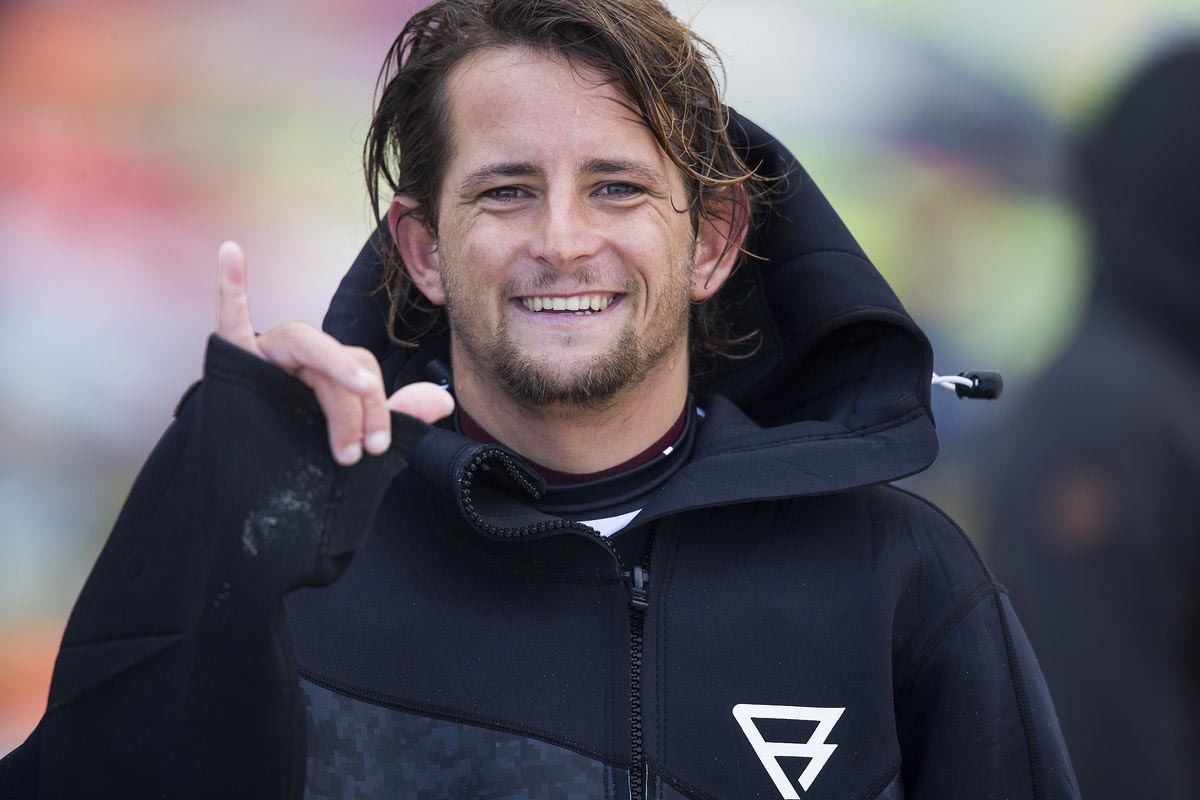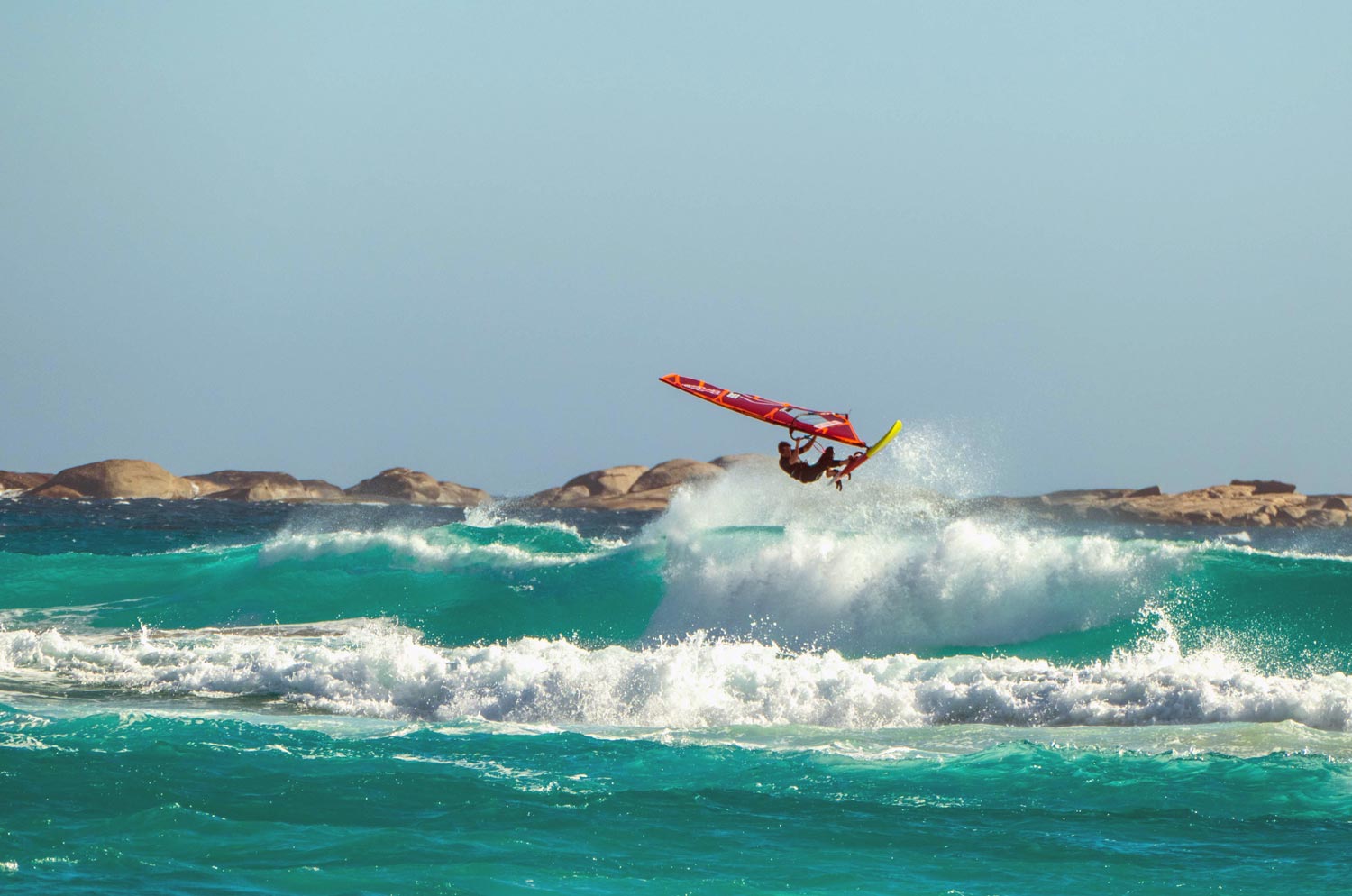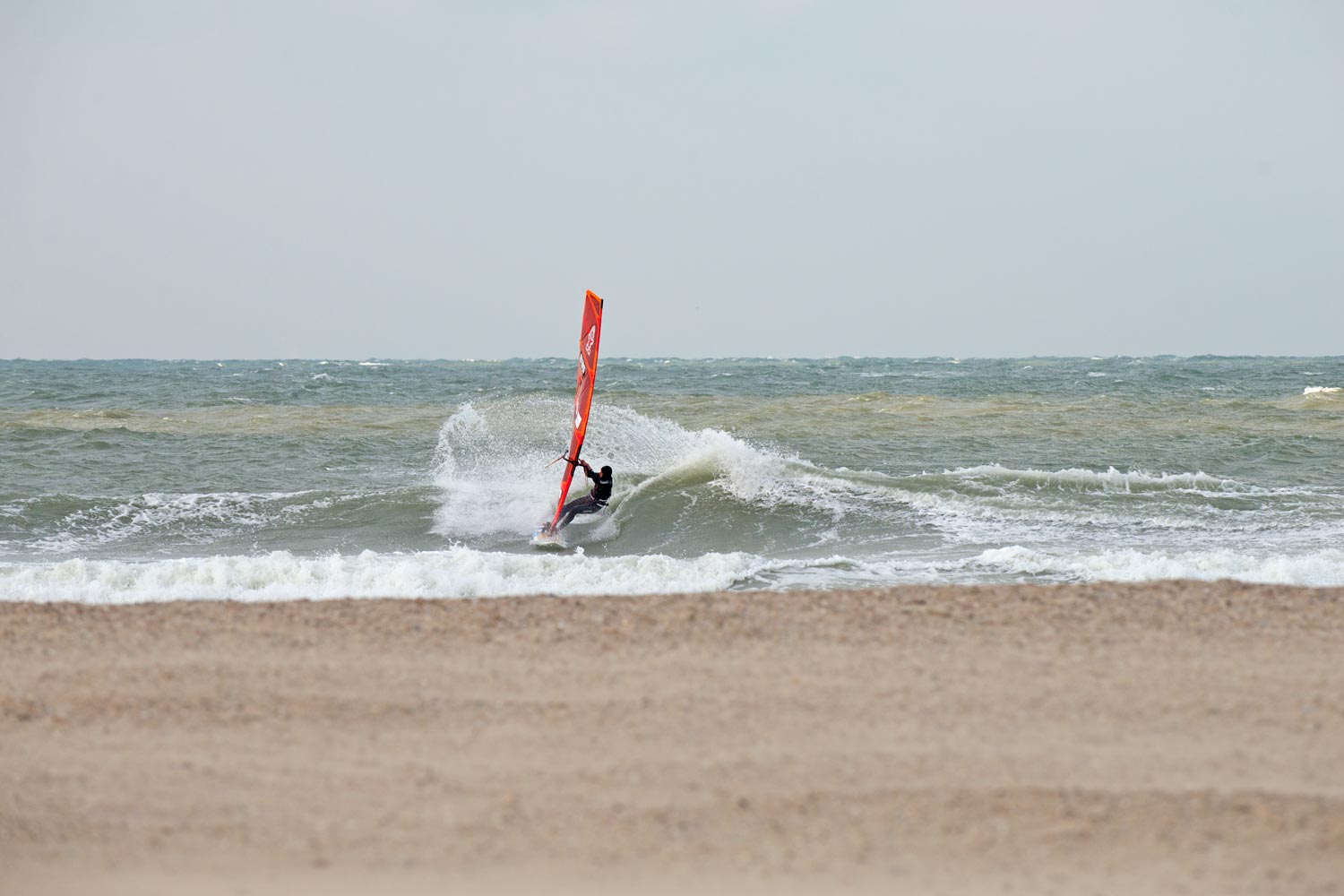2015 Freestyle World Champion Dieter van der Eyken was focusing on the top 20 in waves in 2016 but in the end he managed to finish on a very good 15th place overall. The Belgian, who entered the wave tour in 2015, became a serious opponent in side-onshore conditions and time will tell how far Dieter’s wave competition journey will go. Our question was How can a freestyle windsurfer be so good in waves and what does someone need to make the transition from freestyle to wave. In the past we saw some very good ex-freestyle competitiors enter the wave tour as well, like Marcilio Browne, Ricardo Campello, Diony Guadagnino, Kauli Seadi or in the earlier days Matt Pritchard, Björn Dunkerbeck, Peter Volwater or Josh Stone.
We caught up with Dieter to speak about his transition.

Dieter van der Eyken – Pic: PWA/John Carter
Interview with Dieter van der Eyken – How to transform from a freestyle to wave sailor
Continentseven: You started freestyle at a very young age and were most of the time on freestyle gear in the past. Nowadays you challenge the world’s best wave riders in side onshore conditions or you win local wave events. How is that possible?
Dieter van der Eyken: To be honest I actually used to sail in waves before I started with freestyle windsurfing. In the summer holidays we always travelled to the North of Portugal for a month. So I have been playing in waves already since I’m 3 (on the bodyboard) and surfing since I’m 7. This is probably the background of my passion for wave sailing. I always loved sailing in the waves but as good freestyle conditions occure more often than wave conditions in the Netherlands I forgot about that for a few years. During some trips I would still score some waves but sadly enough this would only be less than 10 times a year. I always had an eye for it I guess thanks to the surfing and still remember a session we had during the “Crowning” (a competition organized by O’Neill in the Benelux) where we got cross off conditions and nice waves at Terschellingen. There were quite some of the Belgium wave locals there and one of them came up to me asking “where did you learn to wave ride like that, not in the pool (the pool of Brouwersdam) I guess?”
Continentseven: When did you decide to sail in waves more often? Was there a reason for your change or a special moment which made you realize, to refocus on wave sailing?
Dieter van der Eyken: That was probably when I started traveling to Western Australia for the Severne freestyle sail development and winter training. It was one of the first places I really sailed with ground swell on reef breaks and I never missed my freestyle gear during those wave sessions. I still remember my first long trip to Australia when I went to Gnaraloo. Because there weren’t that much waves yet on the first day I thought it would be a good idea to take out the freestyle board for a session as the forecast was good for the next days wave wise. I think I was on it for 15 minutes because even though the waves were small I couldn’t resist to ride the waves. Who would go freestyling at Gnaraloo anyway??!! I was like a little kid who just got his brand new toy and took every wave I could (without dropping in on others, I think..). I didn’t touch my freestyle gear for the next 4 days and just enjoyed riding waves! After that trip I started to sail more often in waves when I could but still had my focus completely on freestyle. Besides the few weeks in Australia I didn’t get much chances to sail in the waves, and all the time and money I had went mainly into training freestyle. The real point of focussing on waves more came 3 years ago when I did a 2,5 month long trip to Australia, I could really improve a lot that winter and won the Belgium championships the year after. At that point the PWA Freestyle tour had only 3 events left and after doing the same events for 5 years I felt like I needed a new challenge in windsurfing. This was the challenge to compete on the wave tour full time to motivate me even more for both disciplines when I was sailing.

Aerial in Western Australia by Dieter van der Eyken
Continentseven: What are the differences between freestyle and wave sailing, except the moves or conditions?
Dieter van der Eyken: Yeah there are some differences. In wave sailing your stance is wider to improve your bottom turns and I also sail my boom quite a bit lower on my wave sails compared to my freestyle sail. You also sail a bit more from of the fins and in general the boards are a lot smaller and more radical in their response. In jumps you also feel a difference between the freestyle sails and the waves sails but in general I can make the transition very easy!
Continentseven: As the stance or position is different, was it difficult to adapt or switch disciplines in the beginning?
Dieter van der Eyken: I didn’t really have much problems to adapt as I knew from surfing how to use the wave to get speed. I straight away started using the power of the wave during my wave riding rather than just the power of the sail (which is one of the basic mistakes you see from freestylers going into the waves for the first time). Besides that the guys from Severne (especially Ben Severne himself) would give me shit if I wasn’t properly using my rails during my turns, which sometimes was hard to admit but helped me a lot in the long run! I’ve been lucky enough to travel to Australia for the last few years and learned a lot from the locals there. I went from boards that where mainly good for jumping to proper wave riding boards, changed my stance, the fin position and setup along the way to improve my style on the wave step by step.

Dieter van der Eyken at one of his wavy home spots in Domburg – Pic: Continentseven|Kerstin Reiger
Continentseven: That sounds like you had the perfect plan to get ready for the competitions. You made it in the top rankings at the 2016 PWA World Cup in El Medano, Tenerife and are 15th in the 2016 PWA overall ranking. Did you ever believe you could make it in the top 16 that fast ?
Dieter van der Eyken: My goal this year was making the top 20 and score at least one good result (with my eyes mainly on Tenerife for this). I have been training hard in the winter over the last 3 years to improve my wave skills and didn’t join the tour till I knew I actually could beat at least half of the fleet if I could put a good heat together. Besides that I was very fired up for Tenerife after my 25th place in Pozo where I definitely had an unlucky draw and a few things that didn’t go my way (it still frustrates me now as just passing one heat would have put me into the top 12 overall). I like Medano a lot and for a change I had a good draw in the double (not easy but definitely possible). I had my mind set to at least making the top 16 there and managed to put good heats together especially wave riding wise making it all the way till the top 10. We exactly got the conditions I like with not too strong wind and good waves to ride!
Continentseven: Did you use wave gear from the beginning on?
Dieter van der Eyken: I used wave boards from the start but used freestyle sails in waves at the beginning. I didn’t have the budget back than to buy an extra set of wave sails. As soon as Severne saw I took it a bit more serious they helped me out with a set of wave sails as well and since 4 years I have been using the S-1 for wave sailing!
“I never would have become Freestyle World Champion if I didn’t make the choice to enter the wave tour as well.”
Continentseven: Did wave sailing enrich your freestyle and vice versa?
Dieter van der Eyken: Yeah it definitely helped me in a very good way and I could probably say I never would have become Freestyle World Champion if I didn’t make the choice to enter the Wave tour as well. It opened my eyes to new perspectives and put less pressure on those few freestyle contests we had. Besides that I would sometimes not freestyle for a while and be more stoked about it when I did freestyle again. I remember thinking both before the event in Leucate as Fuerteventura, damn I should have trained more freestyle but ended up with just having a lot of fun and sailed better consistent heats. Also the sailing in waves helped me to make quicker decisions as you can’t hold back or wait for the good moment to jump or hit that lip. In freestyle I used to wait for the perfect conditions before doing a trick but since I joined the waves I’m less picky and can commit better to some air moves than before. In wave all the competition experience from freestyle helped me to stay calm during my heats. In freestyle we perform up to 14 moves in 7 minutes while in wave you have up to 14 minutes to just get 1 jump and 2 waves in, so sometimes half of your heat has passed without doing anything good. When you then look on your watch and see you have another 7 minutes left you can just reset the watch in your mind! But this only works for places like the Canaries but when you are fighting a shore break in Sylt those 12 minutes do pass almost faster than a 7 minute heat in freestyle.
Continentseven: Would you like to win a wave world title?

Dieter van der Eyken Statment Wave tour
Continentseven: Is it easier to transform from a freestyle windsurfer to wave windsurfer or the other way around?
Dieter van der Eyken: The easiest is to go from freestyle to wave. In freestyle you get so much feeling for the sail and the board, which makes it a lot easier to progress once you know where you have to work on. Plenty of freestylers got good in wave sailing later on in their career but nobody went from being a top wave sailor to being a top freestyler.
Continentseven: Some moves in wave sailing are heavily influenced from the modern freestyle. Is that a big advantage for you?
Dieter van der Eyken: It makes it easier as you already know the movements to land the moves quicker. The hard part is to make it look like a proper wave ride and hit the right section while you do the tricks above the lip. I do think though that making proper turns is what makes you a good wave sailor and this takes time & practice!
“Making proper turns is what makes you a good wave sailor and this takes time & practice!”
Continentseven: So it’s a hard long process to transform into a stylish wave windsurfer?
Dieter van der Eyken: Yes, definitely! It takes time to get good turns and you have put in the time to ride as much waves as possible to get good at it. Some guys love to jump more and just end up jumping most of the time before they really learn to enjoy the riding. I have always loved riding much more than jumping and quite a lot of times have to push myself to get better in jumping as well even when I’m on the spot which is better for jumps than wave riding. Besides that, board choice does quite a lot, there are plenty of boards out there that can help you to progress quicker into a better wave rider and make it look good. The most important here is to play around with baseplate position, fin sizes and boom hight to improve step by step. In the beginning you probably want to use smaller fins to make it easier to turn the board in tight corners and as you learn to get more drive out of your bottom turn by the wave you will slowly move to longer fins to give you that little bit extra drive towards your top turn.

Back loop by Dieter van der Eyken in Tenerife – Pic: PWA/John Carter
Continentseven: How important is the gear? Would you recomment a freestyler to make the first experiences in waves with freestyle windsurfing gear? And how much gear is necessary? Most of the pros don’t own a bigger sail size than 5.3m.
Dieter van der Eyken: I think you need to have a wave board to at least start getting into the wave sailing. The sail is less important as this makes a less big impact compared to the board. Depending on where you live you don’t need that much of gear. I would probably have only one 76 liter wave board and 4 sails (3.6 4.0 4.4 4.8) in case I was a non-professional sailor being from Europe. For competitions you always need more as you want the best performing gear in all kind of conditions. I really like Thruster setups myself but also don’t mind twin fins on some days especially if you have to deal with slower waves which are less ideal for Thrusters (but by taking a smaller fin and moving the back fin a bit more forward it still works good). I don’t think people need a custom board straight away and I almost use only production boards besides my 70 liter one which is based of the 72 Ultra Kode but made out of Polyester by Mark Stone. I do advice to not necessarily go for a full carbon board, but if possible the wood version or the carbon wood version. This gives a bit more flex in the board and makes it feel less stiff in the turns. You will however plane a little bit slower as it isn’t as light as the full carbon boards. If you are more of a jumper you will probably also enjoy the higher top speed from the full Carbon once more.
©continentseven.com 2017
